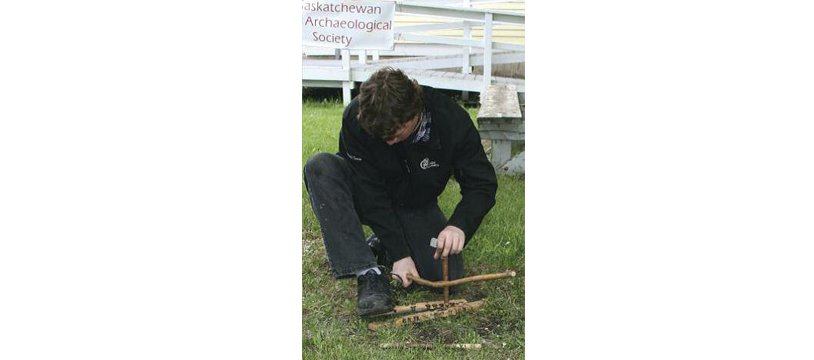
ArchaeoCaravan out in Saskatchewan
Related Programs
Cultural Areas
Heritage
This has been an exciting year for the Saskatchewan Archaeological Society (SAS). Acting executive Director Kim Cloutier says the SAS’s success comes largely from two new initiatives designed to introduce archaeology to those who are unfamiliar with the practice.
“Through the Society’s activities and educational resources, we aim to engage people so they become archaeological stewards, protecting our past for future generations,” she says. So far, archaeological “newcomers” have embraced these new activities.
The Society typically hosts two hands-on, hands-dirty, field schools in the province – one at South Branch House, a probable fur-trading post location along the South Saskatchewan River, near the village of St. Louis; the other at various locations in Wanuskewin Heritage Park. The field schools are practical ways for archaeologists of all experience levels (including no experience) to participate in site surveying and excavation.
This summer, Cloutier notes, the Saskatchewan Archaeological Society added a third field school to the list by partnering with engineering consulting firm, Stantec, for a project in Hudson Bay. Stantec was excavating near Hudson Bay, and the town requested a public component for the dig. The SAS was excited by the partnership and coordinated and supervised 17 volunteers from the community while “providing new exposure for people in an area where not a lot of archaeological opportunities for the public have happened,” says Cloutier.
The other summer project, with even more potential for an introduction to archaeology, is the re-tooling of a former SAS ArchaeoCaravan Program. The ArchaeoCaravan was developed as a way for Grade 4 to 9 teachers and educators to bring a glimpse of archaeology into the school curriculum by showing how various aspects of archaeology relate to subjects the children study in school. To aid the educators, the SAS developed a mobile activity centre to demonstrate how artifacts were made and used, and to give an understanding of past lifestyles and the importance of Saskatchewan history.
In June, the SAS partnered with the Allan Community Heritage Society and museum and various community members to bring the ArchaeoCaravan to Allan’s Family Day in the Park. Children and parents explored the ArchaeoCaravan through hands-on activities, such as rock-painting, potterymaking, fire-starting and a traditional spear-throwing game known as atlatl.
The Allan activities were part of a pilot project done in partnership with museums Association of Saskatchewan to assess the potential of this program’s use at other museums. “It was a premiere to see how the community responded; how feasible the project was; and how many people were needed to run it,” notes Cloutier. The community wants to do it again for Family Day in the Park, and Allan is in one of the museum networks (Quill Plains museum Network) we wish to explore.”
With the success during the Allan Family Day, the SAS is gauging interest in similar events for museums in two regional museum networks in the artifact-rich areas near Saskatoon. The Society hopes to run the program as a two-part offering for museums in the future. First, SAS would “assess and advise museums on their archaeological artifacts, possibly helping with identification and ideas for optimum interpretation.” Secondly, we would also provide the ArchaeoCaravan for them to invite children and community members to the museum for a day of hands-on archaeological experience,” Cloutier says. While details of the initial assessment are pending, the program has received positive attention from educators and museums and will likely move forward in the New Year.
The Saskatchewan Archaeological Society is dedicated to the education and conservation of archaeology and promotes responsible stewardship of Saskatchewan’s rich and diverse archaeological heritage. The SAS receives Annual Global Funding from SaskCulture, thanks to support from Saskatchewan Lotteries Trust Fund for Sport, Culture and Recreation.

